

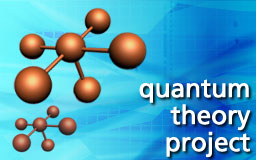

About Us - QTP History
In the late 1950's then Graduate Dean Linton E. Grinter, Chemistry Chairman Harry H. Sisler, and Physics Chairman Stanley S. Ballard, all of the University of Florida, had the idea to create a strong graduate program in the emerging field of Theoretical Chemical Physics and Quantum Chemistry. To lead that charge they selected a dynamic Swedish scientist with exceptional energy and unique abilities to realize his dream of creating a truly international research and teaching program. That choice defined the development of the Quantum Theory Project for many years to follow.
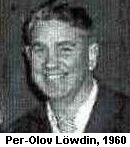 The
arrival of Per-Olov Löwdin (with the rank of Graduate Research Professor of Chemistry
and Physics) at the University of Florida in 1960, immediately followed
by the appointments of a number of junior faculty (visiting and permanent),
marks the inception of the Quantum Theory Project (QTP), an institute
for research and graduate education in the areas of Theoretical Chemical
Physics and Physical Chemistry. The name itself is worth a historical
aside. Long since shortened, the original name was "Quantum Theory Project
for Research in Atomic, Molecular and Solid State Theory."
The
arrival of Per-Olov Löwdin (with the rank of Graduate Research Professor of Chemistry
and Physics) at the University of Florida in 1960, immediately followed
by the appointments of a number of junior faculty (visiting and permanent),
marks the inception of the Quantum Theory Project (QTP), an institute
for research and graduate education in the areas of Theoretical Chemical
Physics and Physical Chemistry. The name itself is worth a historical
aside. Long since shortened, the original name was "Quantum Theory Project
for Research in Atomic, Molecular and Solid State Theory."
From the beginning QTP was not a separate unit but a joint program of two basic academic disciplines, Chemistry and Physics. Thus, in 1960 the Department of Physics hired John S. Faulkner and Richard F. Wood as Assistant Professors and the Department of Chemistry similarly hired Darwin W. Smith. Those three young scientists, together with then Associate Professor Charles E. Reid, already on the Chemistry faculty, joined Löwdin to form the initial permanent faculty of the QTP. Both Faulkner and Wood spent some time that first year at the Quantum Chemistry Group of Uppsala University in Sweden, Löwdin's home institution, and several young scientists from Uppsala spent one to two years at UF. In this way an exchange of scientists was started between the University of Florida and Uppsala University in QTP's specialties. That particular exchange has continued over thirty years while the tradition of exchanges has been expanded to include other institutions.
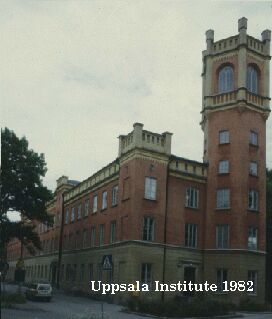 The
first contingent from Uppsala to hold positions of Visiting Assistant
Research Professors in the QTP consisted of Klaus Appel, Jean-Louis Calais,
and Jan Linderberg (1960--61), Jan Nordling (1961--62), and Yngve Öhrn
(1961--63). Other visiting scientists for extended periods during these
early years included Werner A. Bingel (Germany), Joseph O. Hirschfelder
(Wisconsin), G. Ludwig Hofacker (Germany), Egil A. Hylleraas (Norway),
Harold V. McIntosh (RIAS, Maryland), Kimio Ohno (Japan), and Ruben Pauncz
(Israel).
The
first contingent from Uppsala to hold positions of Visiting Assistant
Research Professors in the QTP consisted of Klaus Appel, Jean-Louis Calais,
and Jan Linderberg (1960--61), Jan Nordling (1961--62), and Yngve Öhrn
(1961--63). Other visiting scientists for extended periods during these
early years included Werner A. Bingel (Germany), Joseph O. Hirschfelder
(Wisconsin), G. Ludwig Hofacker (Germany), Egil A. Hylleraas (Norway),
Harold V. McIntosh (RIAS, Maryland), Kimio Ohno (Japan), and Ruben Pauncz
(Israel).
It is interesting to note where some of these young pioneers, who came together at UF during the formative years of the QTP, later found more permanent employment. Appel became the Director of the University Computing Center at Uppsala. Calais was Associate Professor of Quantum Chemistry at Uppsala University. Both are now deceased. Linderberg holds the chair of Theoretical Chemistry at Aarhus University in Denmark. Nordling was Lecturer at Sundsvall University College in Sweden after concluding a successful career in the private computer industry. Both retired in 2004.
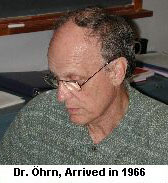 Öhrn
is Professor of Chemistry and Physics at UF since 1966. Bingel held the
chair of Theoretical Chemistry at the University of Gottingen in Germany
until his retirement a few years ago. Hirschfelder was already at the
time one of the scientific pioneers in the field and held the position
of Professor at the University of Wisconsin. He died in 1990. Hylleraas
one of the originators of the field of computational molecular physics
held the chair of Theoretical Physics at Oslo University in Norway. He
passed away in 1967. Hofacker holds the chair of Theoretical Chemistry
at the Technische Universitat at Munich in Germany. McIntosh became professor
at Universidad de Puebla, Mexico. Ohno, now retired, held the chair of
Theoretical Chemistry at Hokkaido University, Japan. Pauncz was Professor
of Chemistry at Haifa University in Israel until his retirement a few
years ago. Faulkner and Wood left QTP in 1964 to take group leader positions
at the Oak Ridge National Laboratories. Faulkner has recently joined
the physics faculty at Florida Atlantic University. Smith left UF in
1967 for the chemistry faculty at the University of Georgia and is now
retired.
Öhrn
is Professor of Chemistry and Physics at UF since 1966. Bingel held the
chair of Theoretical Chemistry at the University of Gottingen in Germany
until his retirement a few years ago. Hirschfelder was already at the
time one of the scientific pioneers in the field and held the position
of Professor at the University of Wisconsin. He died in 1990. Hylleraas
one of the originators of the field of computational molecular physics
held the chair of Theoretical Physics at Oslo University in Norway. He
passed away in 1967. Hofacker holds the chair of Theoretical Chemistry
at the Technische Universitat at Munich in Germany. McIntosh became professor
at Universidad de Puebla, Mexico. Ohno, now retired, held the chair of
Theoretical Chemistry at Hokkaido University, Japan. Pauncz was Professor
of Chemistry at Haifa University in Israel until his retirement a few
years ago. Faulkner and Wood left QTP in 1964 to take group leader positions
at the Oak Ridge National Laboratories. Faulkner has recently joined
the physics faculty at Florida Atlantic University. Smith left UF in
1967 for the chemistry faculty at the University of Georgia and is now
retired.
Those early years established the tradition, which is still very much alive and valuable today, of having a number of active scientists from all over the world as visiting scientists at QTP. This practice created a uniquely open and fertile environment for the exchange of ideas, as well as a truly international network of colleagues and friends.
From the beginning, QTP faculty understood the value of communicating the latest in research findings to graduate students and other young as well as senior scientists eager to join the growing community of quantum chemists and chemical physicists. At that time there were almost no courses and few textbooks on the subject. To fill that gap QTP began annual Winter Institutes (WI) on Quantum Chemistry, Solid-State Physics, and Quantum Biology in 1961. These extremely intense courses, lasting for six weeks or longer, had their first part on the UF campus. Many senior scientists from around the world visited UF for shorter period during the WI. Looking through a list of those names is almost like reading a worldwide Who's Who in those fields of study.
 The Winter Institutes
were partitioned into a Preparatory Part, and one or two Advanced Parts.
The last two weeks of the WI were held on Sanibel Island, just off Ft.
Myers, Florida in the Gulf of Mexico. From the second year the site was
the Casa Ybel Resort, which provided a unique nature setting albeit primitive
facilities. (Casa Ybel was a peculiar collection of modern beach cottages,
1920's beach cottages, motel units, and partitioned old houses most of
which had seen better days.) The Sanibel part concluded with a one week
Symposium, which attracted active scientists from around the world for
a conference program that can be characterized as the most intense (and
exhausting) of any such meetings.
The Winter Institutes
were partitioned into a Preparatory Part, and one or two Advanced Parts.
The last two weeks of the WI were held on Sanibel Island, just off Ft.
Myers, Florida in the Gulf of Mexico. From the second year the site was
the Casa Ybel Resort, which provided a unique nature setting albeit primitive
facilities. (Casa Ybel was a peculiar collection of modern beach cottages,
1920's beach cottages, motel units, and partitioned old houses most of
which had seen better days.) The Sanibel part concluded with a one week
Symposium, which attracted active scientists from around the world for
a conference program that can be characterized as the most intense (and
exhausting) of any such meetings.
Typically the scientific sessions ended at midnight and started at eight thirty in the morning. A total of about 250 participants came each year to the WI and the Sanibel Symposium.
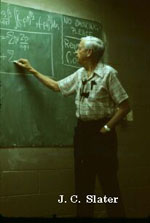 It seems fair to say
that these activities had a significant impact on chemical physics and
physical chemistry in a variety of ways. In this context it is notable
that at most institutions throughout the world a theorist in these fields,
such as a quantum chemist, was, and often still is, the only person with
that specialty on the faculty. To meet a colleague with similar interests
and scientific expertise often would require significant travel. Given
that scenario, it is understandable that the yearly WI and Sanibel Symposium
were embraced with sustained enthusiasm among these scientists. Here
was a series of events, concentrated in time and space, which made it
possible for senior scientists, postdoctoral associates, and graduate
students to meet most of the world's experts in the specialty, to learn
about the latest developments, and to disseminate their own work among
this group for the cost of one trip to Florida.
It seems fair to say
that these activities had a significant impact on chemical physics and
physical chemistry in a variety of ways. In this context it is notable
that at most institutions throughout the world a theorist in these fields,
such as a quantum chemist, was, and often still is, the only person with
that specialty on the faculty. To meet a colleague with similar interests
and scientific expertise often would require significant travel. Given
that scenario, it is understandable that the yearly WI and Sanibel Symposium
were embraced with sustained enthusiasm among these scientists. Here
was a series of events, concentrated in time and space, which made it
possible for senior scientists, postdoctoral associates, and graduate
students to meet most of the world's experts in the specialty, to learn
about the latest developments, and to disseminate their own work among
this group for the cost of one trip to Florida.
In Fall 1964 a major influence on QTP's evolution arrived in the person of John C. Slater, appointed as Graduate Research Professor of Physics and Chemistry. Slater had been Professor and Chairman of the Department of Physics at MIT and had established the Solid-State and Molecular Theory Group (SSMTG) there. Löwdin had spent some time at MIT in the fifties and had established strong contacts with this internationally known group. The arrival of Slater meant a considerable strengthening of QTP in the area of condensed matter theory. James B. Conklin Jr., also from MIT, was appointed Assistant Professor of Physics the same year.
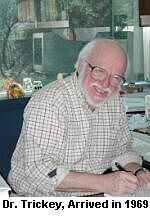 In 1966 the
Yngve Öhrn, joined the QTP
faculty as Associate Professor of Chemistry and Physics, and in the same
year Donald E. Ellis took the position as Assistant Professor of Physics. Ellis
left in 1968 to join the Physics Department at Northwestern University
where he is today.
Timothy M. Wilson, a QTP graduate, held the position of Assistant Professor
of Physics 1968--69, after which he joined the Physics faculty at Oklahoma
State University. In 1968 Samuel B. Trickey came to the Florida Physics
Department and joined QTP in 1969. Another member of QTP, David
A. Micha, joined the Chemistry faculty as an Associate Professor that
Fall. He had spent some time as an Assistant Research Physicist in Keith
Brueckner's group at the University of California, La Jolla after earning
his graduate degrees at Bariloche, Argentina, and Uppsala, Sweden. John
R. Sabin, also a member of QTP, joined the group from the University
of Missouri in 1970, first as a temporary replacement for Yngve Öhrn,
who spent the year at Aarhus University in Denmark, and later as a permanent
faculty member of the Department of Physics. In 1970, one QTP graduate,
John W. Connolly, returned to take the position of Associate Professor
of Physics. After graduation he had been a scientist with United Technologies.
In 1966 the
Yngve Öhrn, joined the QTP
faculty as Associate Professor of Chemistry and Physics, and in the same
year Donald E. Ellis took the position as Assistant Professor of Physics. Ellis
left in 1968 to join the Physics Department at Northwestern University
where he is today.
Timothy M. Wilson, a QTP graduate, held the position of Assistant Professor
of Physics 1968--69, after which he joined the Physics faculty at Oklahoma
State University. In 1968 Samuel B. Trickey came to the Florida Physics
Department and joined QTP in 1969. Another member of QTP, David
A. Micha, joined the Chemistry faculty as an Associate Professor that
Fall. He had spent some time as an Assistant Research Physicist in Keith
Brueckner's group at the University of California, La Jolla after earning
his graduate degrees at Bariloche, Argentina, and Uppsala, Sweden. John
R. Sabin, also a member of QTP, joined the group from the University
of Missouri in 1970, first as a temporary replacement for Yngve Öhrn,
who spent the year at Aarhus University in Denmark, and later as a permanent
faculty member of the Department of Physics. In 1970, one QTP graduate,
John W. Connolly, returned to take the position of Associate Professor
of Physics. After graduation he had been a scientist with United Technologies.
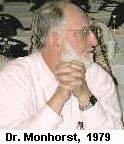 In 1976 Conklin left
the group to become the first Director of CIRCA, the instructional computing
group at UF. Even before that time Conklin and Slater had both played
roles in the early leadership of the UF Computing Center. On July 25, 1976 Slater
died. Shortly thereafter Connolly left to join the National Science Foundation,
where he held several positions of importance, perhaps most notably as
the first program director of the NSF Supercomputer initiative. Trickey
left in 1977 to become Chairman of the Department of Physics at Texas
Tech University. He returned to QTP in 1979. The same year another
QTP member, Hendrik J. Monkhorst, joined UF as Associate Professor of
Physics. Educated in the Netherlands, he had spent several years in the
University of Utah Physics Department working in close collaboration
with Frank E. Harris, a regular lecturer at the Winter Institutes and
now a Resident Adjunct Professor of Chemistry of QTP.
In 1976 Conklin left
the group to become the first Director of CIRCA, the instructional computing
group at UF. Even before that time Conklin and Slater had both played
roles in the early leadership of the UF Computing Center. On July 25, 1976 Slater
died. Shortly thereafter Connolly left to join the National Science Foundation,
where he held several positions of importance, perhaps most notably as
the first program director of the NSF Supercomputer initiative. Trickey
left in 1977 to become Chairman of the Department of Physics at Texas
Tech University. He returned to QTP in 1979. The same year another
QTP member, Hendrik J. Monkhorst, joined UF as Associate Professor of
Physics. Educated in the Netherlands, he had spent several years in the
University of Utah Physics Department working in close collaboration
with Frank E. Harris, a regular lecturer at the Winter Institutes and
now a Resident Adjunct Professor of Chemistry of QTP.
 A major expansion of
the QTP program took place in 1982 with the appointments of Rodney J.
Bartlett, a QTP graduate, and Michael C. Zerner as Professors of Chemistry.
In 1980 QTP made its first small foray into operating its own computersa
move delayed by various state rules. In 1982, the QTP Computing Facility
was created, the position of Computer Manager was established, and George
D. Purvis III, also a QTP graduate, was hired as an Associate in Chemistry
for that post. Bartlett and Purvis had held scientific staff positions
at Battelle Laboratories in Columbus, Ohio, and Zerner had been Professor
of Chemistry at Guelph University in Canada.
A major expansion of
the QTP program took place in 1982 with the appointments of Rodney J.
Bartlett, a QTP graduate, and Michael C. Zerner as Professors of Chemistry.
In 1980 QTP made its first small foray into operating its own computersa
move delayed by various state rules. In 1982, the QTP Computing Facility
was created, the position of Computer Manager was established, and George
D. Purvis III, also a QTP graduate, was hired as an Associate in Chemistry
for that post. Bartlett and Purvis had held scientific staff positions
at Battelle Laboratories in Columbus, Ohio, and Zerner had been Professor
of Chemistry at Guelph University in Canada.
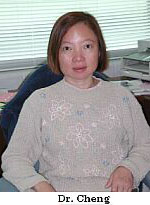 Bartlett was promoted
to Graduate Research Professor in 1987. In 1988 Erik Deumens, from Antwerp
University in Belgium, succeeded Purvis, who moved to CAChe Scientific,
Beaverton, Oregon as Vice President for Research and Development.The
latest additions to the QTP permanent faculty have taken place in the
last few years. Hai-Ping Cheng, with a Ph.D. degree from Donald Ellis
at Northwestern, and Jeffrey Krause, with a Ph.D degree from Stephen
Berry at the University of Chicago, are the newest Assistant Professors
of Physics and Chemistry faculty, respectively.
Bartlett was promoted
to Graduate Research Professor in 1987. In 1988 Erik Deumens, from Antwerp
University in Belgium, succeeded Purvis, who moved to CAChe Scientific,
Beaverton, Oregon as Vice President for Research and Development.The
latest additions to the QTP permanent faculty have taken place in the
last few years. Hai-Ping Cheng, with a Ph.D. degree from Donald Ellis
at Northwestern, and Jeffrey Krause, with a Ph.D degree from Stephen
Berry at the University of Chicago, are the newest Assistant Professors
of Physics and Chemistry faculty, respectively.
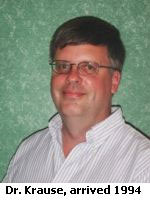 Reid
retired in 1986 and while Professor Emeritus completed a revision of
his book on thermodynamics. He died in 2000. In 1992 Löwdin retired and became Professor
Emeritus. He maintains an active program with a steady flow of manuscripts
until his death in 2000.
Michael C. Zerner's untimely death in 2000 was a serious setback for QTP. (picture of Dr. Jeff Krause, right)
Reid
retired in 1986 and while Professor Emeritus completed a revision of
his book on thermodynamics. He died in 2000. In 1992 Löwdin retired and became Professor
Emeritus. He maintains an active program with a steady flow of manuscripts
until his death in 2000.
Michael C. Zerner's untimely death in 2000 was a serious setback for QTP. (picture of Dr. Jeff Krause, right)
When QTP was founded, the University of Florida had no formal structure for such an interdisciplinary institute. For almost twenty-seven years QTP was an informal association of a number of Chemistry and Physics faculty members and their research groups. By 1986, in response to a general feeling among its faculty that QTP had outgrown its original informal existence, the possibilities for a more formal structure were explored. In 1987, that resulted in a reorganization as the "Institute for Theory and Computation in Molecular and Materials Sciences". However, convenience and familiarity prevails and the Institute is still generally known as QTP. Under the reorganization QTP is, in the jargon of the state of Florida, a type-II institute, with its own bylaws and a modest budget. It continues to be an integral part of the programsof the Chemistry and Physics Departments of UF. The first elected Director of this Institute was Yngve Öhrn, who is stepped down at the end of 1998 and was succeeded by Samuel B. Trickey. Trickey earlier served as the first elected Computer Director of the Institute, an important job, now the responsibility of Erik Deumens.
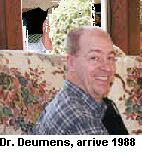 The Winter Institutes
have become less frequent. The latest one (held in 1988) had participants
primarily from the Latin American Countries. The growing interest for
meaningful collaboration with QTP from scientists in Central and South
America has led to a the organization of a two-three day research meeting
on the UF campus preceding the Sanibel Symposium. This Latin American
Workshop attracts between twenty and thirty scientists each year from
universities in Latin America and the Caribbean Basin.
The Winter Institutes
have become less frequent. The latest one (held in 1988) had participants
primarily from the Latin American Countries. The growing interest for
meaningful collaboration with QTP from scientists in Central and South
America has led to a the organization of a two-three day research meeting
on the UF campus preceding the Sanibel Symposium. This Latin American
Workshop attracts between twenty and thirty scientists each year from
universities in Latin America and the Caribbean Basin.
 In
contrast, the Sanibel Symposia have been held in an unbroken string of
annual gatherings. In 1978 the site of the meeting was changed from Sanibel
Island, as a consequence of the sale of the Casa Ybel property for real
estate development. The new location at Palm Coast (on the East Coast
of Florida), was quite a bit closer to the UF campus, and the Sheraton
Hotel there served as an excellent symposium site until 1985. That year
the meeting was moved a couple of miles further North along highway A1A
to the Whitney Marine Biological Laboratories of UF at Marineland. In
1989 the Sanibel Symposium (the name of the original site has been permanently
attached to this meeting) had outgrown the facilities at Marineland and
a new site was found just outside the North gate of St. Augustine, Florida,
the oldest European settlement in the United States. Ponce de Leon Conference
Center has housed the symposia since then, except for 1994, when the
meeting went to the Marriott at Sawgrass, about seventeen miles north
of St. Augustine on the Atlantic coast. The Sanibel Symposium attracts
about 350 scientists every year from over thirty different nations. It
has become an integral part of the activities of QTP. In 2005 the Sanibel
Sympsium venue is Saint Simons Island, GA.
In
contrast, the Sanibel Symposia have been held in an unbroken string of
annual gatherings. In 1978 the site of the meeting was changed from Sanibel
Island, as a consequence of the sale of the Casa Ybel property for real
estate development. The new location at Palm Coast (on the East Coast
of Florida), was quite a bit closer to the UF campus, and the Sheraton
Hotel there served as an excellent symposium site until 1985. That year
the meeting was moved a couple of miles further North along highway A1A
to the Whitney Marine Biological Laboratories of UF at Marineland. In
1989 the Sanibel Symposium (the name of the original site has been permanently
attached to this meeting) had outgrown the facilities at Marineland and
a new site was found just outside the North gate of St. Augustine, Florida,
the oldest European settlement in the United States. Ponce de Leon Conference
Center has housed the symposia since then, except for 1994, when the
meeting went to the Marriott at Sawgrass, about seventeen miles north
of St. Augustine on the Atlantic coast. The Sanibel Symposium attracts
about 350 scientists every year from over thirty different nations. It
has become an integral part of the activities of QTP. In 2005 the Sanibel
Sympsium venue is Saint Simons Island, GA.
A one week course in Applied Molecular Orbital Theory under the directorship of Rod Bartlett, primarily intended for chemists in industry has been part of the QTP agenda for the past few years. Typical attendance is between twenty and thirty for this program that involves several of the QTP faculty, postdoctoral associates, and graduate students. Bartlett has also conducted several ACES II workshops.
 The institute faculty
serve on the editorial boards of many of the scientific journals in chemical
physics and theoretical chemistry, and the editorial offices of Advances
in Quantum Chemistry and the International Journal of Quantum Chemistry
are housed in QTP. Faculty members are active also in national organizations.
Bartlett has served as Chairman-elect and Chairman of the Theoretical
Subdivision of the Physical Chemistry Division of the American Chemical
Society. Micha served as Vice Chairman and Chairman of the Few Body Physics
Topical Group of the American Physical Society. Trickey has served as
chairman of SUPER!, a national organization of (mainly academic) supercomputer
users associated with IBM.
The institute faculty
serve on the editorial boards of many of the scientific journals in chemical
physics and theoretical chemistry, and the editorial offices of Advances
in Quantum Chemistry and the International Journal of Quantum Chemistry
are housed in QTP. Faculty members are active also in national organizations.
Bartlett has served as Chairman-elect and Chairman of the Theoretical
Subdivision of the Physical Chemistry Division of the American Chemical
Society. Micha served as Vice Chairman and Chairman of the Few Body Physics
Topical Group of the American Physical Society. Trickey has served as
chairman of SUPER!, a national organization of (mainly academic) supercomputer
users associated with IBM.
Some QTP faculty have served the University in administrative roles as well. Öhrn was Chairman of Chemistry (1977-1983), as was Zerner (1988-1994). Trickey was Director for Information Technologies at the college level (1986-1990) and has served as Executive Director for the Office of Information Technologies and Services at UF during 1991-1996. David Micha was the cofounder of the Center for Chemical Physics and served as its first elected Director 1982-91). Sabin was named as the College Information Technology Director in 1998.
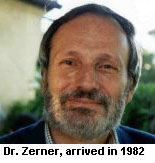 The QTP faculty has
had the good fortune to work with a dedicated secretarial and clerical
staff. Eleanor J. Fox, Philamena V. Pearl, Jacqulyn M. Davis, Evelyn
J. Smith, and Phyllis Durre carried much of the secretarial and administrative
responsibilities during the sixties. Drucilla Bouffard, Josephine Larrauri,
Charlotte Rustin, Laura Stewart, Charlene Catlett, Daryl Moore, Brenda
Foye, Joyce Christianson, Susan Lyon,Robyne Stewart, and Susan Janis
served with distinction during the seventies. Joanne Bratcher, Cynthia
Karle, Arline Succow, Vivian Goeller, Sylvia Whitten, and Barbara Wubbel,
Robin Bastanzi, Jody-Kate Fischer, Clara Reed, and Susan Linsley carried
us through the eighties into the nineties. Leanne Golemo, Heather Lawhorn,
Sharon Stellato, Kathy Fuller and Karen Yanke, Sandra Weakland, and Grace
Kiltie were staff for several years in the nineties. Arlene Rodriguez
worked as the IJQC secretary and left QTP in June of 2005.
Antoinette Knight was senior secretary and went to
Chemistry in 2008.
The QTP faculty has
had the good fortune to work with a dedicated secretarial and clerical
staff. Eleanor J. Fox, Philamena V. Pearl, Jacqulyn M. Davis, Evelyn
J. Smith, and Phyllis Durre carried much of the secretarial and administrative
responsibilities during the sixties. Drucilla Bouffard, Josephine Larrauri,
Charlotte Rustin, Laura Stewart, Charlene Catlett, Daryl Moore, Brenda
Foye, Joyce Christianson, Susan Lyon,Robyne Stewart, and Susan Janis
served with distinction during the seventies. Joanne Bratcher, Cynthia
Karle, Arline Succow, Vivian Goeller, Sylvia Whitten, and Barbara Wubbel,
Robin Bastanzi, Jody-Kate Fischer, Clara Reed, and Susan Linsley carried
us through the eighties into the nineties. Leanne Golemo, Heather Lawhorn,
Sharon Stellato, Kathy Fuller and Karen Yanke, Sandra Weakland, and Grace
Kiltie were staff for several years in the nineties. Arlene Rodriguez
worked as the IJQC secretary and left QTP in June of 2005.
Antoinette Knight was senior secretary and went to
Chemistry in 2008.
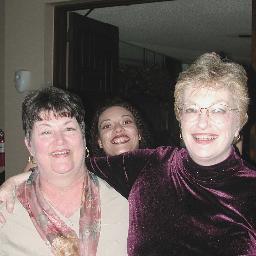 (left: Coralu Clements,
(left: Coralu Clements,
back middle: Arlene Rodriguez ,
right: Judy Parker)
The staff of Judy Parker, Coralu Clements, and Jim Folks are carrying on the QTP tradition of hard work and dedication to the QTP mission.
Associated with the QTP are a number of special individuals and frequent visitors, who have been given the distinction of adjunct QTP faculty. These include Jiri Cizek and Joseph Paldus of the University of Waterloo, Canada, William H. Miller, Professor of Chemistry at the University of California, Berkeley, Jens Oddershede, Professor of Chemistry and Dean of Science at Odense University, Denmark, Jan Linderberg, Professor of Chemistry at Aarhus University, Denmark. A particularly important association was formed in 1996 with Neil Ostlund, CEO of Hypecube, who opened a branch of his company in Gainesville and joined QTP as an adjunct faculty.
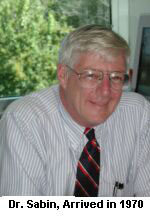 The
scientific achievements of the scientists associated with QTP are numerous
and cover many subfields. The early work of Löwdin introduced new theoretical techniques in
the study of molecular electronic structure. Particularly his work on
electron correlation has been of great importance. His introduction of
the concepts of natural orbitals, bracketing functions, and lower bounds
into the study of molecular systems are widely recognized. His comprehensive
treatment of perturbation methods and mathematical studies of orthogonalization
procedures and linear dependencies are central to applied quantum
chemistry. His study of proton tunneling among base pairs with its implications
for the stability of the genetic code brought quantum chemistry into
the realm of biology.
The
scientific achievements of the scientists associated with QTP are numerous
and cover many subfields. The early work of Löwdin introduced new theoretical techniques in
the study of molecular electronic structure. Particularly his work on
electron correlation has been of great importance. His introduction of
the concepts of natural orbitals, bracketing functions, and lower bounds
into the study of molecular systems are widely recognized. His comprehensive
treatment of perturbation methods and mathematical studies of orthogonalization
procedures and linear dependencies are central to applied quantum
chemistry. His study of proton tunneling among base pairs with its implications
for the stability of the genetic code brought quantum chemistry into
the realm of biology.
Slater developed the so called X-alpha method of electronic structure and with his students applied these ideas to a wide range of molecular and condensed matter problems. This methodology is the precursor to the striking developments in density functional theory, primarily in condensed matter theory, but more recently (and with sudden popularity) in chemistry as well. Some of the most detailed and comprehensive band theory calculations and associated computer codes were developed at QTP by Slater's group. Slater wrote several of his classical monographs during his QTP tenure. Öhrn introduced the propagator or Green's function theory to the field of molecular structure and dynamics and his monograph on this subject with Jan Linderberg was written in the early seventies. Öhrn and Deumens developed and implemented the electron nuclear dynamics (END) theory, which is a time-dependent nonadiabatic approach to molecular processes. Micha developed and implemented few-body and many-body scattering methods for the study of the dynamics of molecular collisions. Trickey developed and implemented rigorous ab initio treatment of thin films. Sabin pioneered novel methodology in the study of stopping of swift particles by various materials. Monkhorst adapted the coupled-cluster theory to the study of many-electron systems including the use of multireference cases, linear response properties, and nonadiabatic effects. Bartlett pioneered the development and application of MBPT and coupled-cluster theory to molecules, including the development of the ACES II program system which offers general molecular applications for energies, gradients, excited states, and spectra. Zerner developed and implemented the now widely used semi-empirical method known as ZINDO for the study of spectra and properties of truly big molecules including molecules with heavy elements. The capabilities of the ZINDO code include solvent effects and geometry optimization routines.
The research interests of the current QTP faculty include the study of elementary chemical reactions, spectroscopy and dynamics of molecules at solid interfaces (Micha, Öhrn, Deumens), the properties of thin films and surfaces, the effect of ionizing radiation on materials (Sabin, Trickey), density functional theory (Trickey), accurate calculation of molecular properties, determination of conformations of new molecularspecies, prediction of heats of formation (Bartlett), development of new methodology for theoretical studies of molecular electronic structure (Bartlett, Monkhorst, Zerner), nonlinear optics (Bartlett, Zerner), solvent effects (Micha, Zerner), spectroscopy of large biomolecules such as the chlorophyll dimer (Zerner), nanostructures of materials, molecular dynamics, collisions of argon clusters with metal surfaces (Cheng), applications of new computer architectures to problems in chemistry (Deumens), laser control of chemical processes (Krause), time-dependent methods for properties and dynamics of molecular systems (Cheng, Deumens, Micha, Öhrn, Krause), novel methods for controlled fusion reactions (Monkhorst).
 The
impact of this research can be measured in various ways and the steady
flow of visitors through QTP is an indication of the broad interest
that exists in the research carried out. Also the numerous invitations
that the institute faculty receives to spek at various national and
international meetings and institutions is is clear proof of the high
regard in which the QTP research activities are held. It is notable,
for instance, that according to the Institute for Science Information
(ISI) Bartlett is the 25th most cited chemist in the world (1981-97).
The
impact of this research can be measured in various ways and the steady
flow of visitors through QTP is an indication of the broad interest
that exists in the research carried out. Also the numerous invitations
that the institute faculty receives to spek at various national and
international meetings and institutions is is clear proof of the high
regard in which the QTP research activities are held. It is notable,
for instance, that according to the Institute for Science Information
(ISI) Bartlett is the 25th most cited chemist in the world (1981-97).
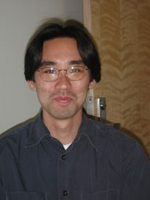 In
2004, Dr. So Hirata joined the QTP Faculty as a assistant professor
in Chemistry. He had once been Dr. Rodney Bartlett's Postdoctoral
Research Fellow in 1999. His group is developing an artificial intelligence
system that performs tedious mathematical derivations and computer
implementations of new chemical theories whose complexity exceeds normal
human comprehension. The group applies chemical theories to elucidate
the properties of molecules that are vital to combustion, environmental
and interstellar chemistry. They also study the initial chemical processes
(excitation and ionization of water clusters) of the radiation damage
to living tissues. (picture of Dr. So Hirata, right)
In
2004, Dr. So Hirata joined the QTP Faculty as a assistant professor
in Chemistry. He had once been Dr. Rodney Bartlett's Postdoctoral
Research Fellow in 1999. His group is developing an artificial intelligence
system that performs tedious mathematical derivations and computer
implementations of new chemical theories whose complexity exceeds normal
human comprehension. The group applies chemical theories to elucidate
the properties of molecules that are vital to combustion, environmental
and interstellar chemistry. They also study the initial chemical processes
(excitation and ionization of water clusters) of the radiation damage
to living tissues. (picture of Dr. So Hirata, right)
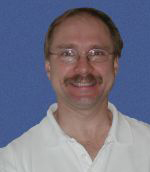
In August of 2005, Dr. Kennie Merz joined the QTP Faculty. He is a professor in Chemistry.(picture of Dr. Kennie Merz, right)
Former Members

Jeff Krause was professor of Chemistry and Physics when he left to be a program officer at the National Science Foundation during the academic year 2007-2008. Since September 2008, he is program officer at DoE in the Office of Basic Energy Sciences.

So Hirata was professor of Chemistry when he left to join the University of Illinois at Urbana-Champaign for the fall of 2010.
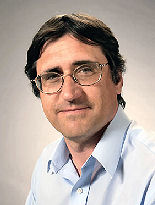
Nigel Richards was Professor of Chemistry when he left
to join the Indiana University-Purdue University Indianapolis
as Chair of the Department
of Chemistry for the Fall of 2012.

Kennie Merz was professor of Chemistry when he left to join Michigan State niversity in the Fall of 2013 as director of the Institute for Cyber-enabled Research (iCER)
Deceased Members
Slater, Löwdin, Reid, Zerner were prominent members of QTP.
